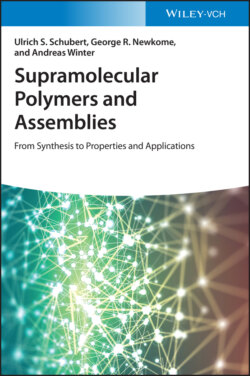Читать книгу Supramolecular Polymers and Assemblies - Andreas Winter - Страница 14
1.3 Supramolecular Polymerization Mechanisms
ОглавлениеThe conventional polycondensation and polyaddition reactions require monomers with (at least) two functional groups by which the covalent bonds are formed. Considering linear polymers, either a single type of monomer bearing two different functionalities (the so‐called AB‐type monomer) or two different monomers each equipped with two functionalities of the same kind (the so‐called homoditopic AA‐ and BB‐type monomers) can basically be employed in this context. Accordingly, supramolecular polymers can be formed by the polyassociation of monomers, which possess (at least) two appropriate binding sites to undergo non‐covalent interactions (Figure 1.2) [39]. As for their covalent counterparts, AB‐type monomers (e.g. Ic) as well as pairs of AA‐ and BB‐type monomers (Ib) can be utilized for this purpose. In principle, one can further distinguish between two different monomer classes: directly interacting monomers (Ia–c) and those that are connected via metal ions (IIa–c). Supramolecular polymerizations according to type‐I typically involve hydrogen‐bonding or ionic interactions as well as host–guest complexation (however, ionic interactions can also be involved in type‐II polymers where coordinative interactions are involved). The self‐complementary monomers (e.g. Ia and IIa) give supramolecular polymers with only a single type of monomeric unit. Accordingly, complementary binding units can be employed to assemble homopolymers (i.e. Ic and IIc) as well as alternating copolymers (i.e. IIb and IIc).
Figure 1.2 Schematic representation of the different types of supramolecular polymerization.
Source: Winter et al. [39]. © 2012 Elsevier B.V.
In general, the formation of polymers, via a polycondensation or polyaddition, represents a kinetically controlled process [26]: the potential barrier for the forward reaction (i.e. the polymerization) is much lower than for the backward reaction (i.e. depolymerization). As a consequence, neither changes in concentration (i.e. dilution) nor temperature (i.e. heating) will affect the molar mass or the degree of conversion. In supramolecular polymerizations, the situation is much more complicated – due to the (partially) reversible character, depolymerization must be considered. Thus, heating or dilution of a kinetically unstable supramolecular polymer will have a tremendous effect with respect to the molar mass – unlike for a common macromolecule, a decrease of Mn will be the result. According to Carothers' equation (Eq. (1.1)), the molar mass of polymers, which have been prepared by either a polyaddition or a polycondensation, can be correlated to the monomer conversion. However, for supramolecular polymers, featuring a certain degree of reversibility of the non‐covalent interactions, the molar mass will mainly depend on the strength of these interactions, i.e. their association constants (Ka values). As depicted in Figure 1.3, both high Ka values and high monomer concentrations are required to obtain the supramolecular polymers with high DPs. Besides these considerations, other parameters, such as concentration, temperature, and the particular reaction conditions (i.e. presence of additives or reagents, etc.), will also have an impact on the entire assembly process.
(1.1)
where DP: degree of polymerization, p: monomer conversion.
Figure 1.3 Representation of the theoretical DP as a function of the association constant (Ka in M−1) for a typical supramolecular polymerization according to an isodesmic model at two different concentrations.
Source: Brunsveld et al. [27]. © 2001 American Chemical Society.
This assumption, however, represents only a simplification of the actual mechanism of a supramolecular polymerization – even when only considering the thermodynamic equilibrium state, where assemblies are formed that, ideally, retain their polymeric structure over time. In this respect, three main mechanisms can be listed (Figure 1.4) [26]:
1 The isodesmic supramolecular polymerization (IDP) is comparable to the step‐growth polymerization of esters (i.e. showing a broad dispersity, Đ) and the DP is strongly dependent on the Ka value of underlying supramolecular interaction.
2 The ring‐chain‐mediated supramolecular polymerization features an equilibrium between supramolecular cyclic species and linear polymer chains.
3 The cooperative supramolecular polymerization shows a nonlinear growth of the polymer chains and is typically nucleated.
Figure 1.4 Schematic representation of the three main mechanisms known for the supramolecular polymerization processes: (a) isodesmic, (b) ring‐chain mediated, and (c) cooperative supramolecular polymerization.
Source: Winter et al. [39]. © 2012 Elsevier B.V.
Going beyond the “traditional” equilibrium state, supramolecular polymerizations leading to assemblies in either dissipative nonequilibrium or even non‐dissipative nonequilibrium states (i.e. kinetically trapped or metastable ones) have recently attracted substantial interest. In these cases, the progress of the polymerization is heavily dependent on the applied preparative method (the so‐called pathway selection), and an in‐depth knowledge of the kinetics is required. In particular, the association rates for each single step become more important. These issues have recently been discussed by Sorrenti et al. in a tutorial review [40].
